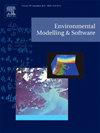Spatiotemporal flood depth and velocity dynamics using a convolutional neural network within a sequential Deep-Learning framework
IF 4.8
2区 环境科学与生态学
Q1 COMPUTER SCIENCE, INTERDISCIPLINARY APPLICATIONS
引用次数: 0
Abstract
Computational hydrodynamic models support river science and management. However, current physics-based models face computational challenges; they require extensive processing time for large-scale two-dimensional flood simulations. Despite the success of Deep Learning (DL) applications in generating inundation maps, accurate prediction of unsteady flood hydrodynamic maps remains challenging. This paper compares traditional approaches to a novel DL approach, which integrates convolutional neural networks with long short-term memory, to deliver precise, rapid, and continuous simulation of the spatiotemporal dynamics of river floods. This is the first DL framework able to generate essential hydrodynamic variables: water depth, velocity magnitude, and flow direction maps. Water depth and velocity magnitude predictions across the testing dataset are robust, with average RMSE of 0.14 m and 0.02 m/s, respectively. The DL predictions are 415 times faster compared to traditional computational approaches, representing a paradigm shift in hydrodynamics modeling that advances long-term flood simulations and resilient river management.
时序深度学习框架中使用卷积神经网络的时空洪水深度和速度动态
计算水动力模型支持河流科学和管理。然而,目前基于物理的模型面临着计算方面的挑战;大规模二维洪水模拟需要大量的处理时间。尽管深度学习(DL)在生成淹没图方面取得了成功,但准确预测非定常洪水水动力图仍然具有挑战性。本文将传统方法与一种新颖的深度学习方法进行了比较,该方法将卷积神经网络与长短期记忆相结合,以提供精确、快速和连续的河流洪水时空动态模拟。这是第一个能够生成基本流体动力学变量的深度学习框架:水深、速度大小和流向图。整个测试数据集的水深和速度大小预测非常稳健,平均RMSE分别为0.14 m和0.02 m/s。与传统计算方法相比,DL预测速度快415倍,代表了水动力学建模的范式转变,推动了长期洪水模拟和弹性河流管理。
本文章由计算机程序翻译,如有差异,请以英文原文为准。
求助全文
约1分钟内获得全文
求助全文
来源期刊

Environmental Modelling & Software
工程技术-工程:环境
CiteScore
9.30
自引率
8.20%
发文量
241
审稿时长
60 days
期刊介绍:
Environmental Modelling & Software publishes contributions, in the form of research articles, reviews and short communications, on recent advances in environmental modelling and/or software. The aim is to improve our capacity to represent, understand, predict or manage the behaviour of environmental systems at all practical scales, and to communicate those improvements to a wide scientific and professional audience.
 求助内容:
求助内容: 应助结果提醒方式:
应助结果提醒方式:


